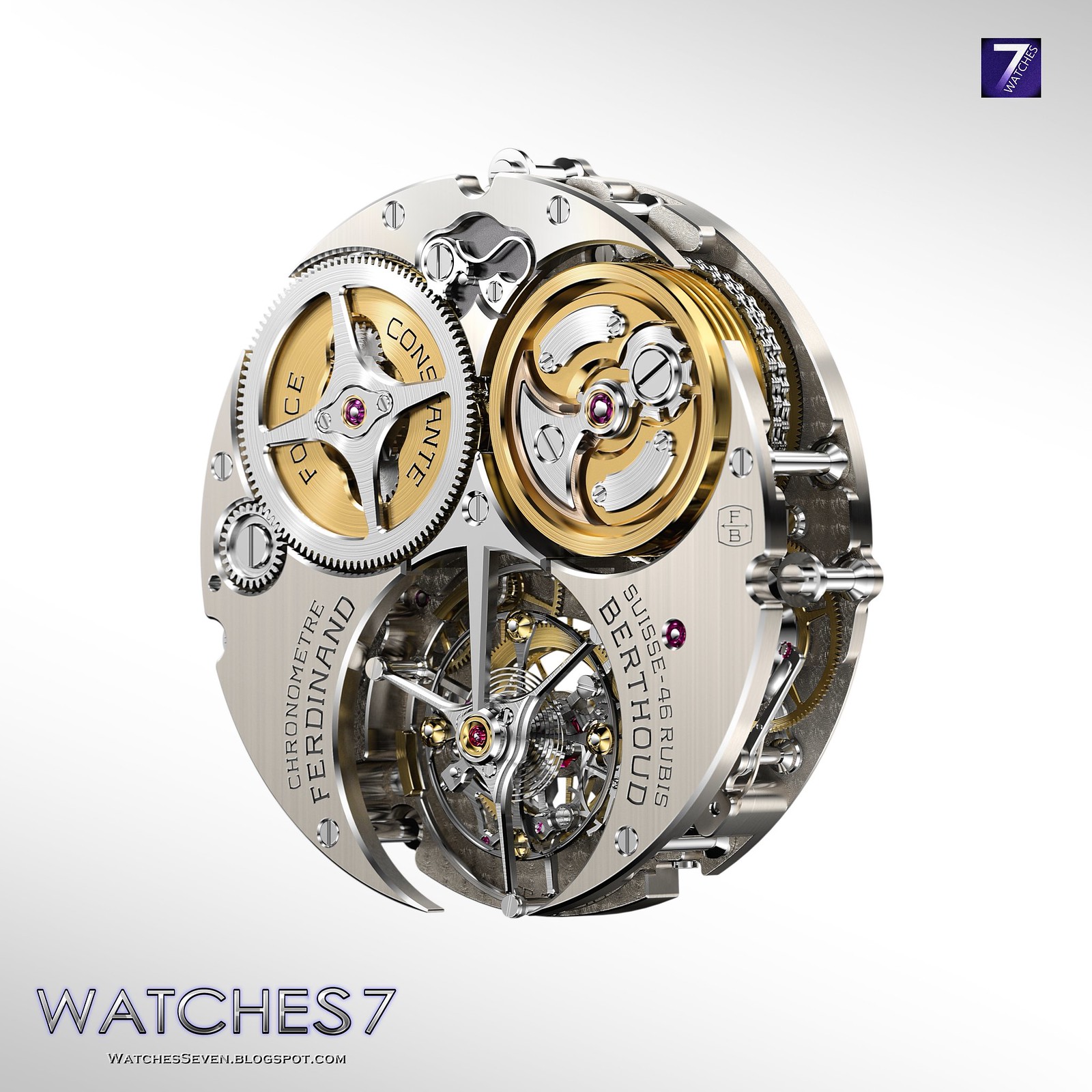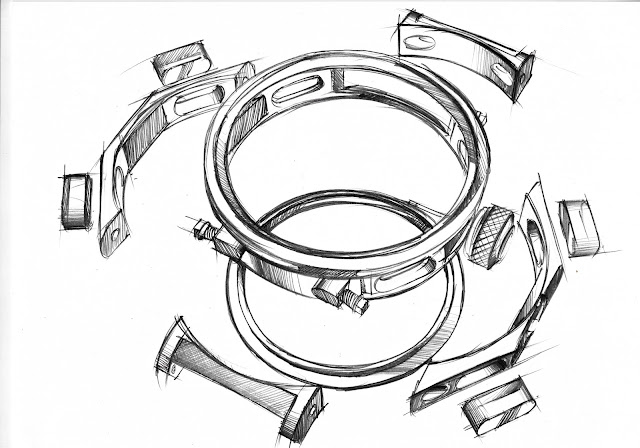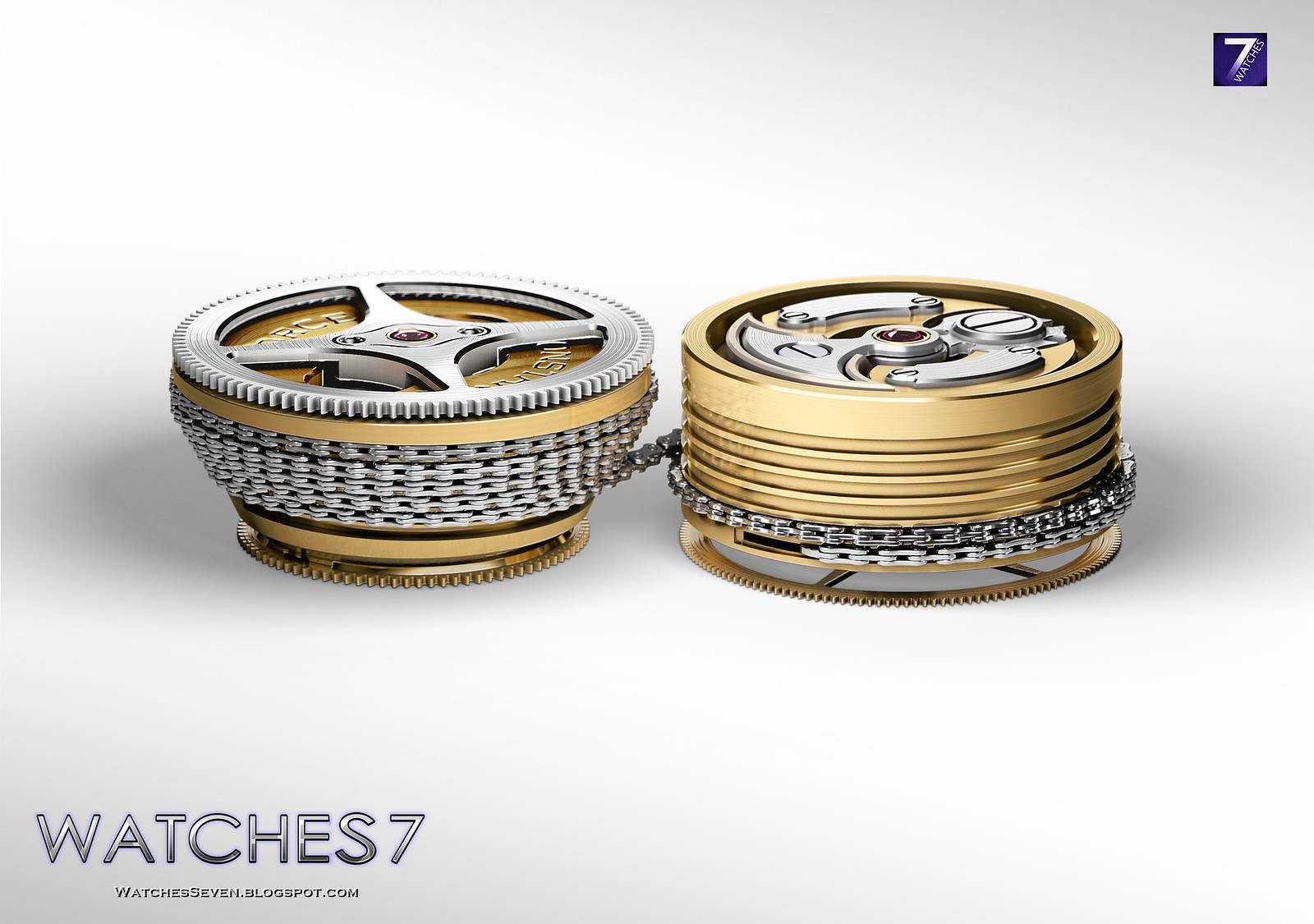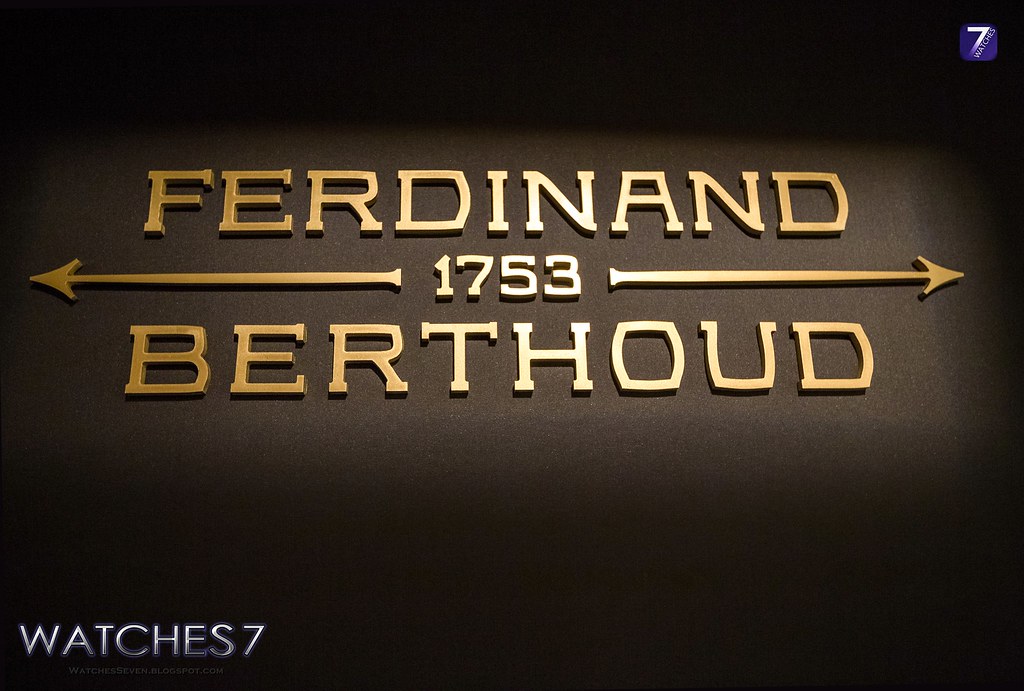FERDINAND BERTHOUD – Chronométrie Tourbillon FB 1.3 Platinum & Ceramic 44 mm Limited Edition
Click, to see the large size. ▶ BIG FOTO
Born from an approach that is unique in the world of modern watchmaking, the new Chronomètre FERDINAND BERTHOUD FB 1.3 is the most exclusive to date, coming on the heels of the FB 1.1 chronometer that won the “Aiguille d’or” Grand Prix award at the 2016 Grand Prix d’Horlogerie de Genève, and the FB 1.2. Distinguished by its unique shape and complexity, the platinum case frames a partially openworked nickel silver dial featuring an understated and distinctive play on colours.
Click, to see the large size. ▶ BIG FOTO
Its movement is endowed with complications inspired by the 18th century Ferdinand Berthoud chronometers that served as reliable scientific instruments. Nonetheless, even terms such as “suspended tourbillon”, “constant force” or “fusee-and-chain transmission” cannot begin to express the true sophistication of this exceptional calibre.
Click, to see the large size. ▶ BIG FOTO
hilosophy driving Chronométrie FERDINAND BERTHOUD cannot be summed up as a tribute, a reproduction or even a reinterpretation, since it is in fact far more demanding. It embodies a contemporary translation of the quest for excellence pursued by the master horologist who was appointed clockmaker to the French King and the French Navy.
Click, to see the large size. ▶ BIG FOTO
The Chronomètre FERDINAND BERTHOUD FB 1 was the result of an innovative horological approach. Its design, its movement, its finishing and indeed everything to do with this tourbillon and constant force chronometer are highly specific and correspond to an uncompromising pursuit of excellence.
Click, to see the large size. ▶ BIG FOTO
Chronométrie FERDINAND BERTHOUD stemmed from a very special mind-set that breathed life into this project, powered by personal passion. That of Karl-Friedrich Scheufele, President of Chronométrie FERDINAND BERTHOUD, who since 2006 has been patiently putting together a major collection of objects relating to time measurement in the L.U.CEUM: the in-house museum based in Fleurier and showcasing a number of remarkable works by Ferdinand Berthoud.
A PHILOSOPHICAL APPROACH
Fired by respect for Ferdinand Berthoud, a native of the Val-de-Travers who went on to become a horologist, inventor and talented author, Karl-Friedrich Scheufele set up a team dedicated to offering connoisseurs the kind of chronometers that Ferdinand Berthoud might have created if he were still alive today.
Click on the mouse wheel to see the large size ... BIG FOTO
To support this approach, a specific development process was put in place by Karl-Friedrich Scheufele and his team. FERDINAND BERTHOUD chronometers comprise a wealth of aesthetic and technical details that call for authentic expertise and considerable know-how. The Chronomètre FERDINAND BERTHOUD 1.3 is thus naturally produced in a 50-piece limited numbered series.
A UNIQUE CASE DESIGN
The Chronomètre FERDINAND BERTHOUD FB 1.3 picks up all the aesthetic and technical features of the previous versions that were respectively crafted in 18-carat white gold (FB 1.1) and 18-carat rose gold (FB 1.2).
Click, to see the large size. ▶ BIG FOTO
The 44 mm-diameter case of this watch sits naturally and comfortably on the wrist. Composed of a 950 platinum cylinder housing the movement, it comprises two octagonal-shaped side pieces in polished platinum that contribute to its distinctive shape.
Click, to see the large size. ▶ BIG FOTO
The latter is inspired by an overhead view of a marine chronometer fitted inside its case: its round shape is cut through by the arms of the gimbal suspension that holds it in place when the ship is at sea. The grey ceramic lugs are secured to the case middle by two stylised titanium bolts marking the starting points of the hand-stitched double-sided alligator leather strap.
Click, to see the large size. ▶ BIG FOTO
The same ceramic is also present on the medallion adorning the knurled platinum crown. Finally, four ‘portholes’ cut out from the sides of the case provide a chance to admire the fusee-and-chain mechanism in action, as well as to allow light to flood through the movement.
GREY AND BLACK
Another opening in the satin-brushed nickel silver dial reveals the wheel driving the tourbillon carriage and the seconds wheel to which the central seconds hand is fitted, an unusual feature on a tourbillon.
Click, to see the large size. ▶ BIG FOTO
This slim black hand sweeps around a translucent sapphire railtrack circle around the rim of the dial. The hours and minutes are offset at 12 o’clock on a black lacquered subdial bearing white Arabic numerals and white gold cut-out hands.
Click, to see the large size. ▶ BIG FOTO
The same black shade also graces the chamfered edges of the dial openings. The nature and origin of the Chronomètre FB 1.3 are also indicated on this large dial that is engraved with the inscription “Chronomètre Val-de-Travers Suisse”. Far more than merely representing a signature or an appellation of origin, it proudly proclaims the model’s identity.
Click, to see the large size. ▶ BIG FOTO
A CHARACTERISTIC PILLAR-TYPE STRUCTURE
The way the FB-T.FC calibre is built is a truly unique phenomenon on the contemporary watchmaking scene. This hand-wound movement features 15 bridges and three half-bridges in nickel silver, framed by polished titanium pillars surrounding the mechanical organs.
Click, to see the large size. ▶ BIG FOTO
This construction is typical of 18th century marine chronometers, and enables the portholes of the Chronomètre FERDINAND BERTHOUD FB 1.3 to reveal the interior of the watch.
Click, to see the large size. ▶ BIG FOTO
Equally high aesthetic standards apply to the design of all components, and especially to the symmetrical visual balance characterising the various sets of components.
EQUALISING TORQUE
This movement is one of the rare examples to feature a fusee-and-chain transmission, which is the oldest historical solution developed to ensure constant force for the escapement. This system acts like an automatic gear box, with the torque delivered by the barrel varying according to the level of winding.
Click, to see the large size. ▶ BIG FOTO
When the movement is fully wound (53 hours of power reserve), the chain is entirely coiled around the small end of the fusee and the barrel spring is at maximum power.
Click, to see the large size. ▶ BIG FOTO
This force dwindles in the course of time, as the chain coils around the drum, moving from the small to the large end of the spindle-shaped fusee.
Click, to see the large size. ▶ BIG FOTO
The variation in the diameter of the fusee compensates for the reduction of the mainspring torque. The escapement thus receives constant energy, thereby equalling out the amplitude of the balance wheel and thereby enhancing the movement’s timekeeping precision.
THE QUEST FOR SLENDERNESS
The distinctive nature of the FB-T.FC lies in the fact that its barrel and fusee are reversed, upside down, and above all suspended – meaning they are held on one side only.
Click, to see the large size. ▶ BIG FOTO
This helps save a few precious millimetres and contributes to the overall slimness of the calibre. At just 7.96 mm thick, the movement powering the Chronomètre FERDINAND BERTHOUD FB 1.3. is the thinnest in its category and a patent has been duly filed for this construction.
SAFEGUARDING THE MOVEMENT
When the mainspring is associated with a fusee, the barrel drum turns in one direction while the spring is unwinding, and in the other during winding, thus serving to coil the chain.
Click, to see the large size. ▶ BIG FOTO
During the winding of this type of mechanism, the movement generally stops running. To counteract this effect, the FB-T.FC is equipped with a distinctively designed differential gear, enabling the balance-wheel to continue oscillating even during winding and thus preserving the movement’s precision timekeeping properties. Another patent has also been filed for this device.
GENTLE WINDING
The winding mechanism fitted with a pinion featuring cone-shaped toothing, together with a large-diameter knurled crown, enables smooth winding of the movement – a gentle motion that naturally enhances the quality of the rapport established between the watch and its owner, which plays an essential role in the case of a hand-wound watch.
Click, to see the large size. ▶ BIG FOTO
FORCE AND SECURITY MEASURES
As typically found on fusee-and-chain mechanisms, the barrel of Calibre FB-T.FC is equipped with a “Maltese Cross” stopwork device. The latter serves to limit the number of winding turns of the mainspring to around six, and to use only the most stable portion of this spring – thereby breaking free of its far ends. This device also servers as a buffer when the barrel is fully wound. At that point, the mainspring torque exerts a 3 kg force, which is considerable for components measuring just a few millimetres.
Click, to see the large size. ▶ BIG FOTO
To perfect the security of the movement, the engineers at Chronométrie FERDINAND BERTHOUD have endowed the crown with a dynamometric function serving to avoid any damage to the movement that might be caused by excessive winding.
SUSPENDED MOBILE POWER-RESERVE CONE
The highly sophisticated power-reserve indication device warranted a patent in its own right. A truncated cone moves up and down along an arbor connected to the barrel. This suspended cone is topped by a feeler spindle in the form of a mobile arm tipped with a watch jewel.
Click, to see the large size. ▶ BIG FOTO
Its position on the cone reflects the state of wind. This feeler spindle is in turn connected to the hand on the power-reserve display, which features graduations engraved on the baseplate and visible through a dial opening. This daring mechanism provides a highly accurate indication of the movement’s power reserve.
TOURBILLON WITH CENTRAL SECONDS
Teamed with the seconds wheel and pinion, the tourbillon of Calibre FB-T.FC comprises 67 components assembled within a titanium carriage measuring 16.55 mm in diameter, and fixed to an arrow-shaped steel arch whose tip points towards the space between the barrel and the fusee.
Click, to see the large size. ▶ BIG FOTO
A large variable-inertia balance-wheel is regulated and balanced by four gilded nickel silver inertia-blocks. It is coupled with a self-compensating regulating balance-spring in a stainless alloy, featuring a Phillips outer terminal curve (overcoil) manually shaped by the expert hands of the women serving as balance-spring fitters at Chronométrie FERDINAND BERTHOUD.
Click, to see the large size. ▶ BIG FOTO
To poise the escapement’s unbalance, two 18-carat gold inertia-blocks ensure the uniformity of the weights of this large-size tourbillon. This tourbillon contributes to earning Calibre FB-T.FC its chronometer title awarded by the Swiss Official Chronometer Testing Institute (COSC).
Click, to see the large size. ▶ BIG FOTO
One particular characteristic makes this tourbillon extremely distinctive: although it performs one rotation per minute, it does not display the seconds. The Chronomètre FERDINAND BERTHOUD FB 1.3 is one of the rare tourbillon models to have a central sweep-seconds hand. The latter is extremely long, slim and made of bronze, displaying the seconds with extreme accuracy and in a remarkably stable manner.
NOBLE MATERIALS
Within the traditional approach to watchmaking, construction and mechanical structure are inseparable from the choice of materials and the quality of the finishing. In this respect, the movement of the Chronomètre FERDINAND BERTHOUD FB 1.3 is in a league of its own.
Click, to see the large size. ▶ BIG FOTO
The bridges of Calibre FB-T.FC are made of non-treated German silver: a copper, zinc and nickel alloy that is particularly brilliant when polished, yet also extremely fragile.
Click, to see the large size. ▶ BIG FOTO
Any imperfection is irreparable and the part must be discarded. Nickel silver is also distinguished by its warm grey colour easily recognised by connoisseurs.
NOBLE FINISHING
The stainless steel arrow-shaped tourbillon bridge is decorated with the utmost care: the upper side is specular polished, the flanks are straight-grained, the angles are polished and the underside is circular-grained and smooth polished. All levels of the tourbillon carriage, with its titanium components, are entirely chamfered.
Click, to see the large size. ▶ BIG FOTO
Some surfaces are polished, others circular satin-brushed, sandblasted or smooth polished. The lever bridge is entirely chamfered, while its visible side features a specular-polished finish and its invisible side is straight-grained. Further up in the gear train, the power-reserve cone is mirror-polished across its inner surface, while the upper and undersides are circular satin-brushed.
Click, to see the large size. ▶ BIG FOTO
Two small steel plates are screwed to the cover of the barrel drum: one bears the watch’s limited-edition number, while the other is left blank to be engraved with the initials of its future owner.
Click, to see the large size. ▶ BIG FOTO
The 790-part chain measuring 285 mm long is also entirely hand-finished. The sides and studs are satin-brushed and the flat surfaces are polished.
NOBLE SKILLS
Whatever their position and their function, these component finishing operations are entirely done by hand using traditional tools, in the workshops of Chronométrie FERDINAND BERTHOUD.
Click, to see the large size. ▶ BIG FOTO
The quality control of this finishing is performed at a far higher degree of magnification than usual, under a 6x loupe. Under such intense scrutiny, no detail, however tiny, goes unnoticed. No error, imperfection or insufficiency is tolerated. Such is the horological excellence cultivated by Chronométrie FERDINAND BERTHOUD as part of its unfailing commitment to precision for explorers.
Click, to see the large size. ▶ BIG FOTO
This respect for watchmaking tradition, expressed in resolutely modern terms through FERDINAND BERTHOUD chronometers, will remain the core of future developments from the Maison.
Click, to see the large size. ▶ BIG FOTO
-------------------------------------------
Technical Specifications
Model: FERDINAND BERTHOUD FB 1.3
REF. FB 1.3, Platinum and Ceramic 50-piece limited and numbered edition
CASE
Bimetallic in platinum (PT 950) with anthracite grey ceramic lug elements
Total diameter: 44 mm
Thickness: 13 mm
Water resistance: 30 metres
Crown diameter: 9 mm
Numbered edition: 01/50 to 50/50
Dynamometric crown (uncoupling device) in platinum (PT 950) with anthracite grey ceramic medallion
Octagonal case fitted with four watertight portholes in glare-proofed sapphire crystal
Mounting bolts in titanium
Screw-in case-back with glare-proofed sapphire crystal
Domed, arched and glare-proofed sapphire crystal
DIAL
Vertical satin-finish dial made of solid nickel silver material
Cut-out centre and power reserve chamfered by hand and black rhodium-plated
Off-set hours and minutes in matte black-lacquered subdial, white Arabic numerals
Seconds scale in matte translucent sapphire surrounding the dial
Power-reserve scale engraved on the main plate “0_1/4_1/2_3/4_1”
Degree of autonomy indicated by an arrow pointing to the French words “HAUT” (high) and “BAS” (low)
Inscription: “CHRONOMÈTRE VAL-DE-TRAVERS SUISSE”
Hands
18-carat white gold dagger-shaped hours and minutes hands, open-worked and facetted
18-carat gold black nickel-plated dagger-shaped power-reserve hand with curved triangular tip
Bronze black nickel-plated central sweep-seconds hand
Functions
Hours, minutes, seconds and power reserve
MOVEMENT
Mechanical hand-wound Calibre FB-T.FC
Diameter: 35.50 mm
Thickness: 7.96 mm
Lines: 15 ¾
Jewels: 46
Frequency: 21,600 v/h (3 Hz)
Power reserve: 53 hours
- Tourbillon with fusee-and-chain transmission (constant-force device)
Suspended barrel with Maltese cross stop work device (PATENT PENDING)
Suspended power reserve device with mobile cone (PATENT PENDING)
Suspended tourbillon with direct-drive seconds (PATENT PENDING)
- Variable-inertia balance-wheel integrating 2 balance weights sets (gold-plated nickel-silver material)
• Swiss lever escapement
• Nickel-silver half-bridges supported by stylised titanium pillars
• Hand-finished to the highest standards
Parts: 1120 (incl. the chain)
Chain: 790 elements
Chain length: 285 mm
Half-bridges: 18
Pillars: 6
Tourbillon
Rotation: 1 /minuteParts: 67
Carriage: Ø 16.55 mm (titanium material)
Tourbillon carriage fixed by: Three polished titanium pillars.
Tourbillon carriage poised by: Two 18-carat gold studs
Balance wheel: Ø 12 mm (copper-beryllium)
Certification
Officially chronometer-certified by the COSC
STRAP AND BUCKLE
One-piece hand-sewn rolled-edge black alligator leather strap
(115 x 75 mm, buckle 20 mm) (Different sizes available on request)
Double-blade adjustable-length safety folding clasp in platinum (PT 950)
(Pin buckle available on request)
Limited edition exclusive 50 pieces
-------------------------------------------------------------
Chronométrie FERDINAND BERTHOUD SA
Rue des Moulins 20
Case postale 128
2114 Fleurier, Val-de-Travers (NE)
Switzerland
-------------------------------------------------------------------
www.facebook.com - Ferdinand Berthoud
----------------------------------------------------------------------------
www.FerdinandBerthoud.ch
















































